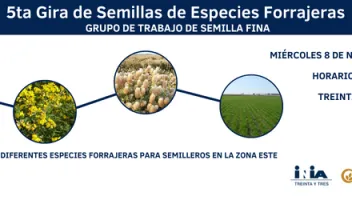Instituto Nacional de Investigación Agropecuaria
Contribution to the knowledge of the diversity of ectomycorrhizal fungi of native forests of Uruguay. [poster].

The ectomycorrhizal fungi (ECM) of Uruguay have been relatively little studied and most of the knowledge about them comes from studies on cultivated exotic species, such as the commercial Eucalyptus and Pinus spp., and other ornamental species. The objective of this work is to make an approximation to the diversity of ECM fungi in native riparian forests in different geographical areas of Uruguay.

Sostenibilidad ambiental de los sistemas de producción arroceros.

El artículo sintetiza los principales mensajes vertidos por investigadores de diversas instituciones en una jornada de divulgación de resultados de varios proyectos de investigación interinstitucionales sobre la sostenibilidad de los sistemas de producción de arroz en Uruguay. ------- Información generada en el marco de los Proyectos ANII-Innovagro:FSA_PP_2018_1_148336:Evaluación de la sostenibilidad ambiental de sistemas de producción arroceros de intensidad variable. / FSA_PI_2018_1_148442:Eficiencia del uso del agua y nutrientes en rotaciones arroceras bajo irrigación.
Jornada de campo ganadería en la zona baja. "Capitalizando las sinergias del arroz y la soja". Unidad Experimental Paso de la Laguna.

Avanzando en la integración de los componentes del sistema arroz-ganadería, productores arroceros y ganaderos, técnicos de instituciones y empresas participaron en una nueva jornada de campo, esta vez con foco en la fase ganadera del sistema.
Genotype by environment interaction characterization and its modeling with random regression to climatic variables in two rice breeding populations.

ABSTRACT.- Genotype by environment interaction (GEI) is one of the main challenges in plant breeding. A complete characterization of it is necessary to decide on proper breeding strategies. Random regression models (RRMs) allow a genotype-specific response to each regressor factor. RRMs that include selected environmental variables represent a promising approach to deal with GEI in genomic prediction. They enable to predict for both tested and untested environments, but their utility in a plant breeding scenario remains to be shown.
Paginación
- Página anterior
- Página 22
- Siguiente página

